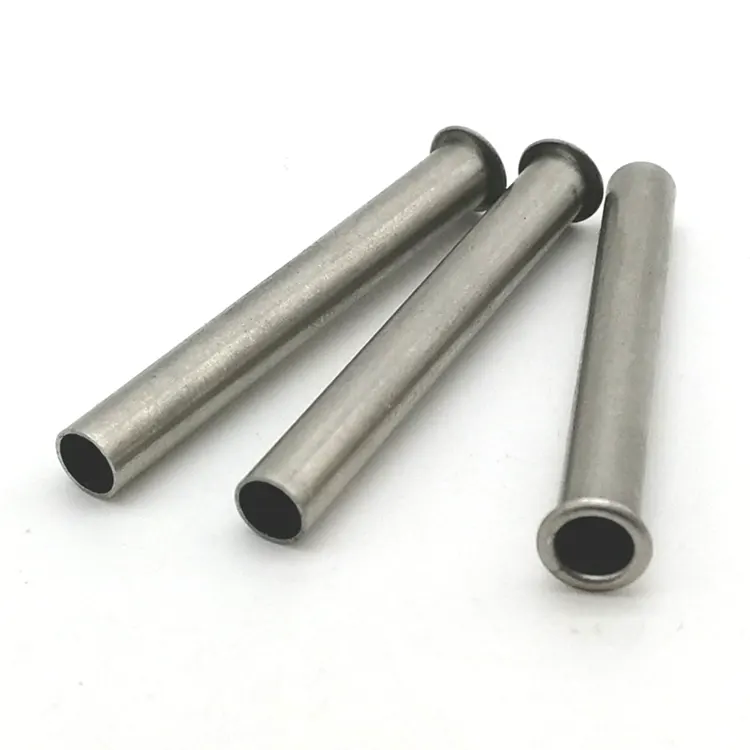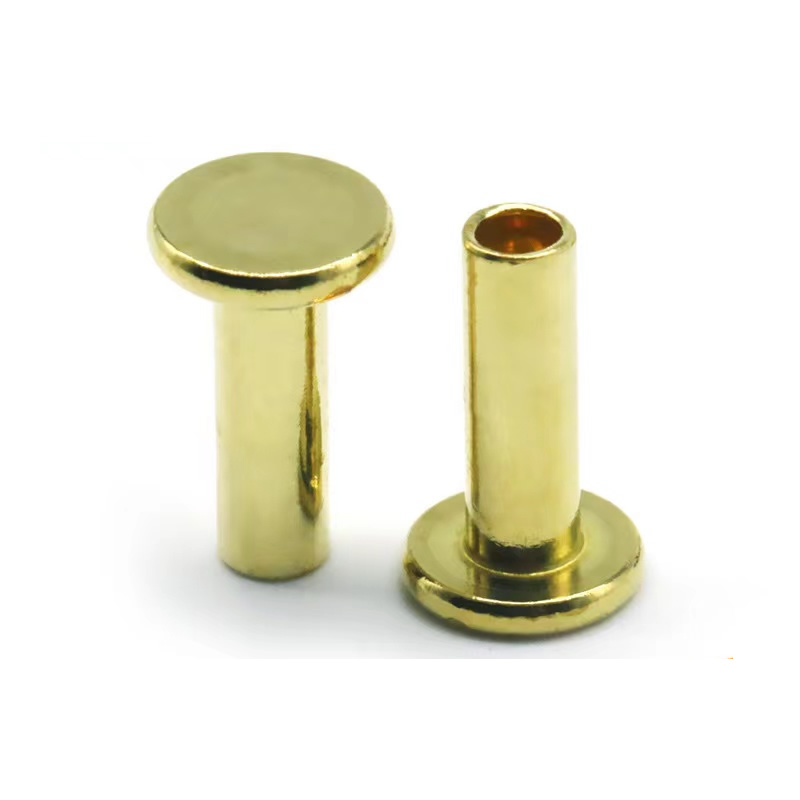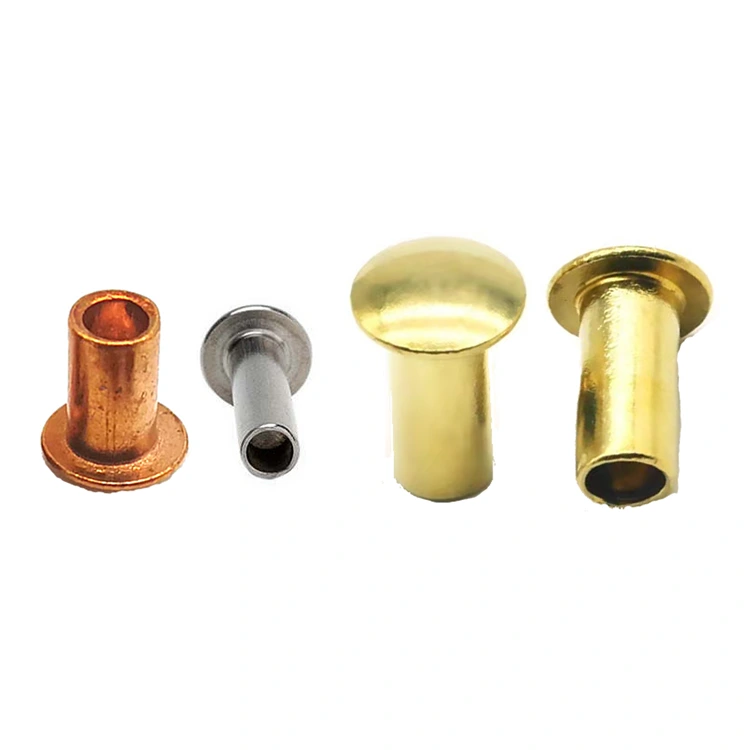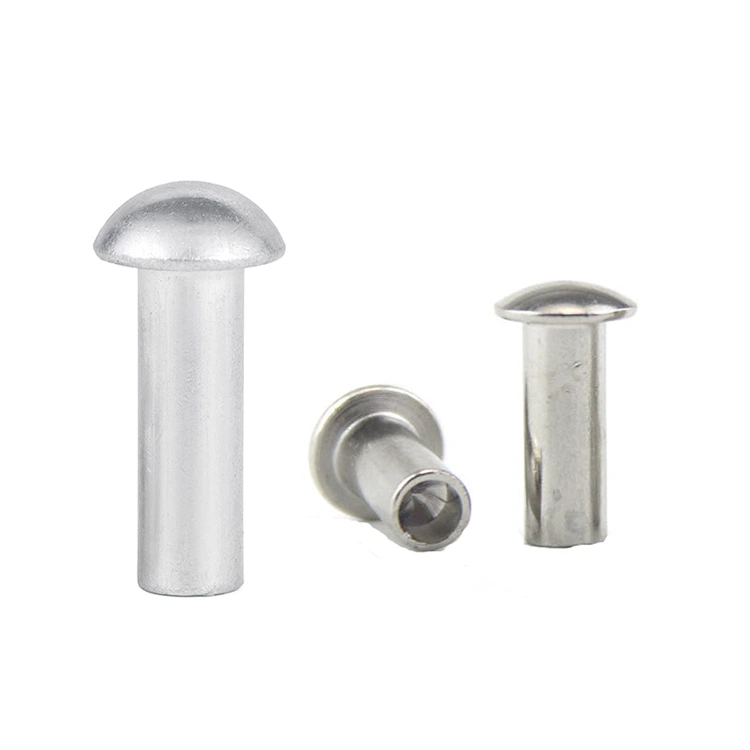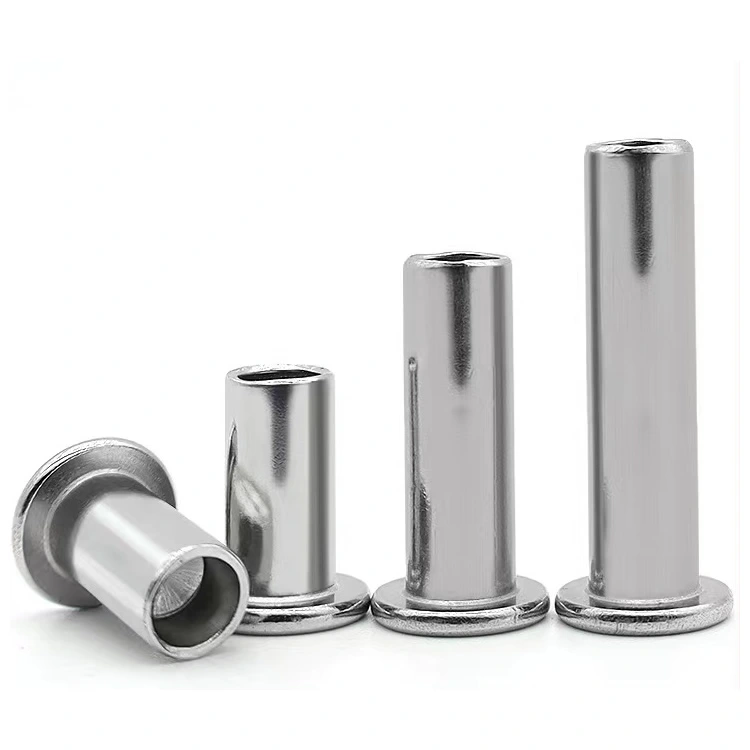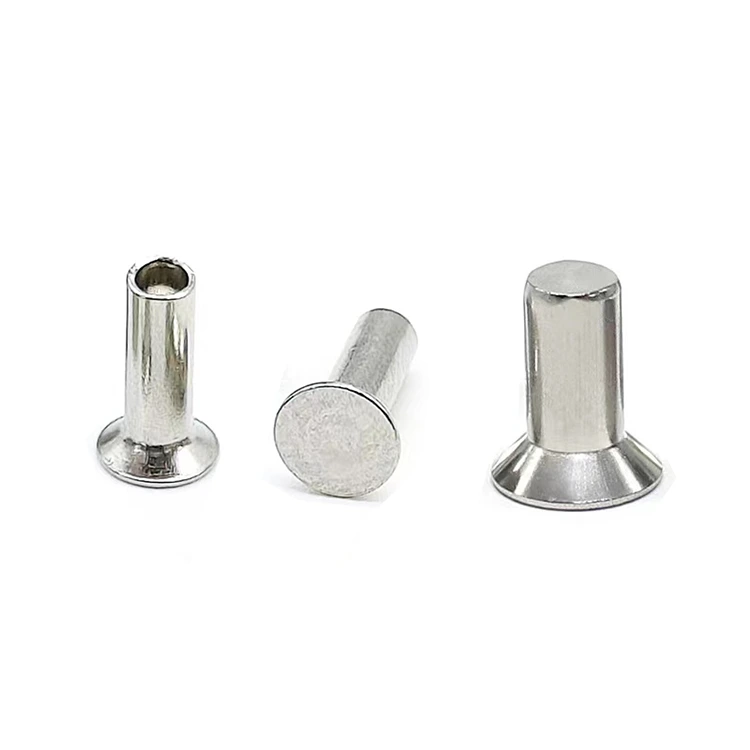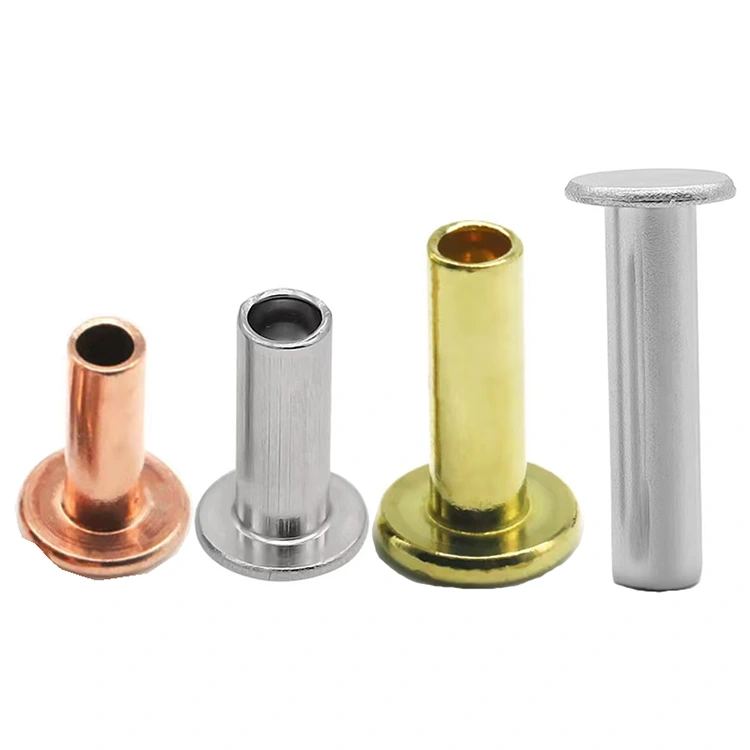Semi tubuläre Nieten
You can purchase Semi Tubular Rivets from Notin with confidence, as we are a proficient producer of high-quality Semi Tubular Rivets. We promise to provide you with the best after-sale service and prompt delivery.
Semi-tubular rivets are a common mechanical fastener widely used in industrial manufacturing, electronic equipment, automotive parts, and other fields. Their structure lies somewhere between solid and hollow rivets, with a solid head and a hollow tail, combining the advantages of both. The following analyzes the characteristics of semi-tubular rivets and their differences from other rivets from various perspectives.
What are semi-tubular rivets?
Semi-tubular rivets typically have a solid cylindrical or round head and a hollow tubular tail. During installation, pressure is applied to the tail using a riveting tool, causing it to curl outward and form a secure locking structure. This process requires no pre-tapping or welding, making it suitable for quick assembly. In contrast, solid rivets require greater pressure to deform, while fully hollow rivets (such as blind rivets) rely on the mandrel to break to secure, requiring higher material strength.
What head shapes are available for semi-tubular rivets?
Semi-tubular rivet head shapes generally include flat heads (flat heads, suitable for applications requiring smooth surfaces), domed heads (semi-circular heads, aesthetically pleasing and practical, commonly used in construction, automotive, and other fields), countersunk heads (heads embedded within the material, suitable for applications requiring concealed connections), and large flat heads. Different head shapes can be selected based on your needs.

Materials and Strength of Semi-tubular Rivets
Common materials for semi-tubular rivets include aluminum, copper, steel, and stainless steel. Aluminum rivets are lightweight and corrosion-resistant, making them suitable for electronic devices; steel rivets are stronger and are often used in load-bearing structures. Compared to solid rivets, semi-tubular rivets are lighter but have slightly lower shear strength. Compared to full tubular rivets, their curled tails provide a larger contact area, resulting in a more stable connection.

What are semi tubular rivets primarily used for?
Typical uses for semi-tubular rivets include:
-Automotive manufacturing: securing interior panels or wiring harness brackets to prevent loosening under vibration.
-Home appliance assembly: connecting metal casings to prevent deformation caused by welding. -Hardware Tools: Assemble movable parts such as pliers and scissors, ensuring a balance between flexibility and durability.

Semi Tubular Rivet Installation Cost
Semi-tubular rivets can be installed with a standard rivet gun or punch, and can be operated by a single person. They are faster than welding or bolting. For example, the cost per aluminum rivet is approximately 0.05-0.3 RMB, which is lower than stainless steel bolts but higher than ordinary blind rivets. Their advantage is that they require no maintenance over long-term use, eliminating the need for anti-loosening washers or regular tightening.
Limitations of Semi Tubular Rivets
The main disadvantages of semi-tubular rivets are:
-Difficulty in Disassembly: Once a joint is established, it requires multiple drilling and destruction methods to remove it.
-Thickness Limitation: The total thickness of the joined materials is generally no more than twice the length of the hollow portion of the rivet.
-Surface Treatment Requirements: For outdoor use, choose galvanized or stainless steel to prevent rust.
Comparison with Other Fasteners
-Bolts and Nuts: They are removable and have a higher load-bearing capacity, but require access from both sides and are more expensive. - Welding: Excellent connection strength, but thermal deformation may affect precision, and it's not suitable for materials like aluminum and copper.
- Adhesives: No mechanical stress, but poor high-temperature resistance and aging resistance.
In summary, semi-tubular rivets strike a balance between lightweight, easy installation, and cost, making them particularly suitable for specialized connections with medium loads. When selecting a rivet, consider material compatibility, environmental conditions, and load-bearing requirements to ensure a suitable match.
- View as
Halbhohlnieten aus Messing
Bei Nuote Metals konzentrieren wir uns auf die Herstellung von Halbhohlnieten aus Messing. Unsere Nieten verwenden hauptsächlich H65-Messing – eine Kupfer-Zink-Mischung, die eine hervorragende elektrische und thermische Leitfähigkeit sowie eine solide Korrosionsbeständigkeit bietet. Dieses Material ist sowohl hart als auch flexibel genug, um gut für Kaltstauch- und Nietverfahren geeignet zu sein. Außerdem hat Messing eine natürliche goldene Farbe. Wenn Sie es also zu dekorativen Zwecken verwenden, ist oft keine zusätzliche Beschichtung erforderlich.
WeiterlesenAnfrage absendenFlachkopf-Halbhohlnieten
Haben Sie sich jemals gefragt, wie unsere Flachkopf-Halbhohlnieten hergestellt werden? Hier ist eine kurze Anleitung:
Zuerst wählen wir den richtigen Metalldraht aus und schneiden ihn auf die exakt benötigte Länge zu. Dann geht es zur Kaltstauchmaschine, die den Draht stanzt und in die Grundnietform formt – dort nehmen der Flachkopf und der Hohlschaft wirklich Gestalt an. Als nächstes folgt die Wärmebehandlung; Wir passen die Zeit und Temperatur je nach Material an, um sicherzustellen, dass jede Niete die richtige Festigkeit und Zähigkeit hat. Danach fügen wir oft eine schützende Oberfläche hinzu – zum Beispiel Verzinkung oder Passivierung –, um ihnen zu helfen, Rost abzuwehren und länger zu halten. Und wir überspringen nie die Endkontrolle: Jede Charge wird überprüft, um sicherzustellen, dass Größe, Verarbeitung und Leistung dem Standard entsprechen.
Wir freuen uns immer, Kunden herumzuführen – wenn Sie jemals in der Gegend sind, lassen Sie es uns einfach wissen und wir organisieren eine Tour!
Halbhohlnieten mit Pilzkopf
Halbhohlnieten mit Pilzkopf verdanken ihren Namen ihrem ausgeprägten kuppelförmigen Kopf, der ein wenig wie eine Pilzkappe aussieht, kombiniert mit einem teilweise hohlen Schaft. Durch dieses Design formt sich die Niete während der Installation selbst und sorgt so für einen starken Halt – perfekt für Anwendungen, bei denen Sie sowohl gutes Aussehen als auch solide Leistung benötigen. Beim Setzen weitet sich das hohle Ende aus und sorgt für einen festen Halt, während der Kopf und der obere Teil des Schafts für zusätzlichen Halt stabil bleiben.
WeiterlesenAnfrage absendenEisen-Halbrohrnieten
Halbrohrnieten aus Eisen sind mechanische Verbinder mit hohlem Endstück. Sie funktionieren, indem sie den hohlen Teil zusammendrücken und ihn nach außen umbiegen, um eine dauerhafte Schnappbefestigung zu schaffen. Die Kernanwendungen konzentrieren sich auf Leichtindustrien wie Bekleidung, Schuhe und Gepäck. Der Einsatz von weichem Drahtmaterial vermeidet Rissbildung bei Nietverbindungen und bietet Kostenvorteile. Nuote Metals ist ein professioneller Hersteller von Halbrohrnieten aus Eisen. Unsere Nieten sind von hoher Qualität und jede einzelne wird einer gründlichen Prüfung unterzogen, um die Kundenzufriedenheit sicherzustellen.
WeiterlesenAnfrage absendenHalbhohlnieten mit Senkkopf
Warum Halbhohlnieten mit Senkkopf anstelle anderer Verbindungsmethoden wählen? Dies liegt vor allem an ihren einzigartigen Vorteilen. Nach der Installation schließt der Kopf bündig mit der Oberfläche ab, wodurch potenzielle Störungen oder Sicherheitsrisiken durch Vorsprünge vermieden werden. Das halbhohle Design macht den Nietvorgang relativ einfach und erfordert keine komplexe Ausrüstung; Sie kann in der Regel manuell oder mit pneumatischen Werkzeugen durchgeführt werden. Dieser Niettyp ist für unterschiedlich dicke Materialien geeignet und kann durch Anpassung der Nietkraft an verschiedene Situationen angepasst werden.
WeiterlesenAnfrage absendenFlachkopf-Halbhohlnieten
Nieten ist eine gängige Methode zur Verbindung von zwei oder mehr Bauteilen in der industriellen Fertigung und bei der täglichen Wartung. Flachkopf-Halbhohlnieten sind eine Art Nieten, die einzigartige Design- und Anwendungsvorteile bieten. Nuote Metals ist ein professioneller Hersteller von Flachkopf-Halbhohlnieten. Wir haben unseren Sitz in Dongguan, China, und verfügen über reichlich Ressourcen für die Oberflächenbehandlung und bequeme Transportmöglichkeiten, was die Kosten der Nietenproduktion senkt.
WeiterlesenAnfrage absenden

